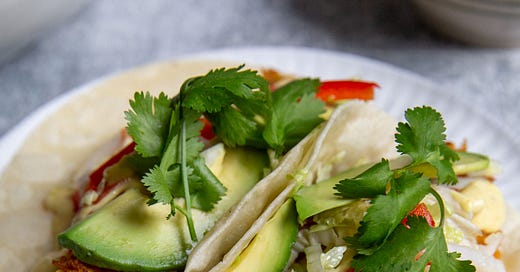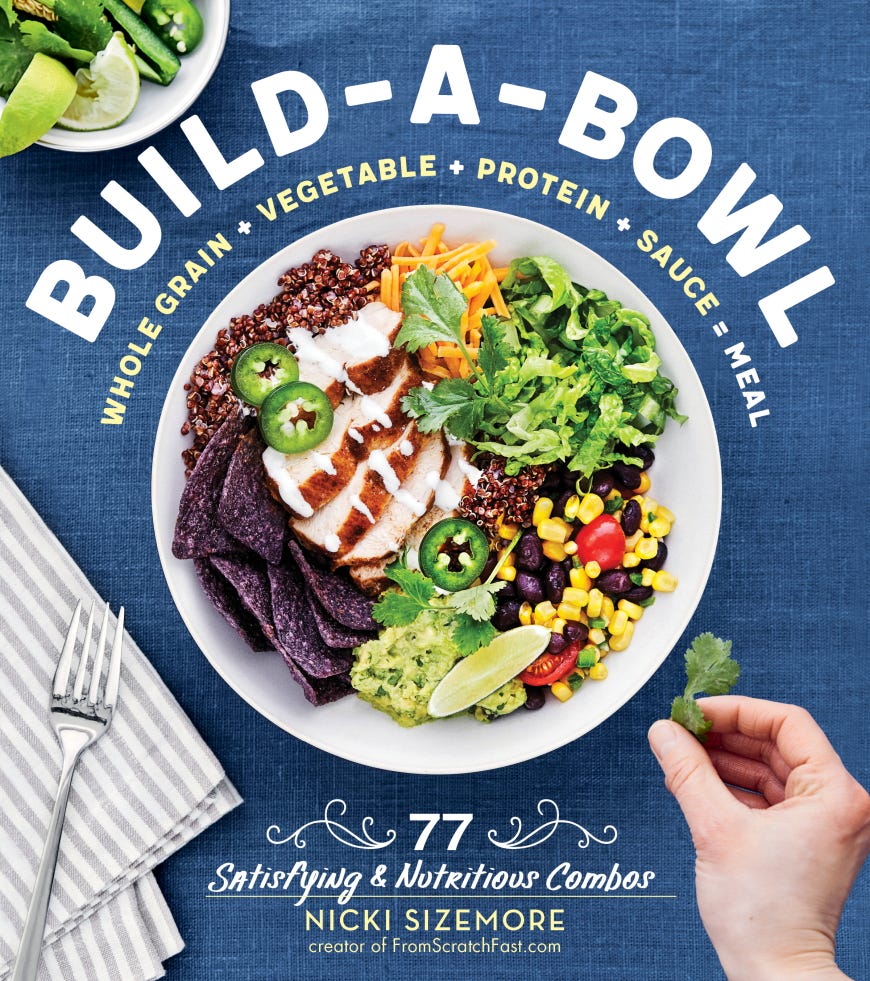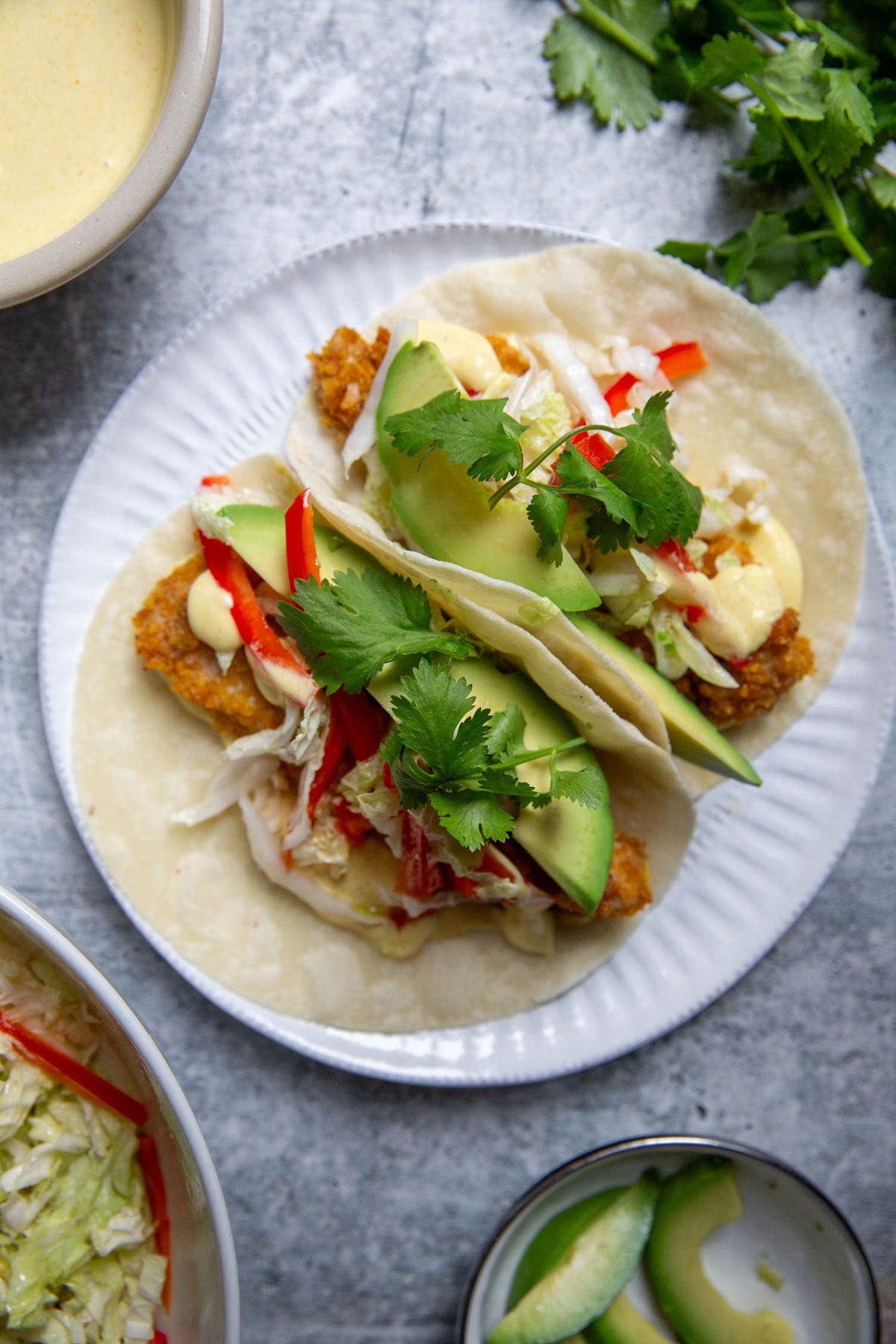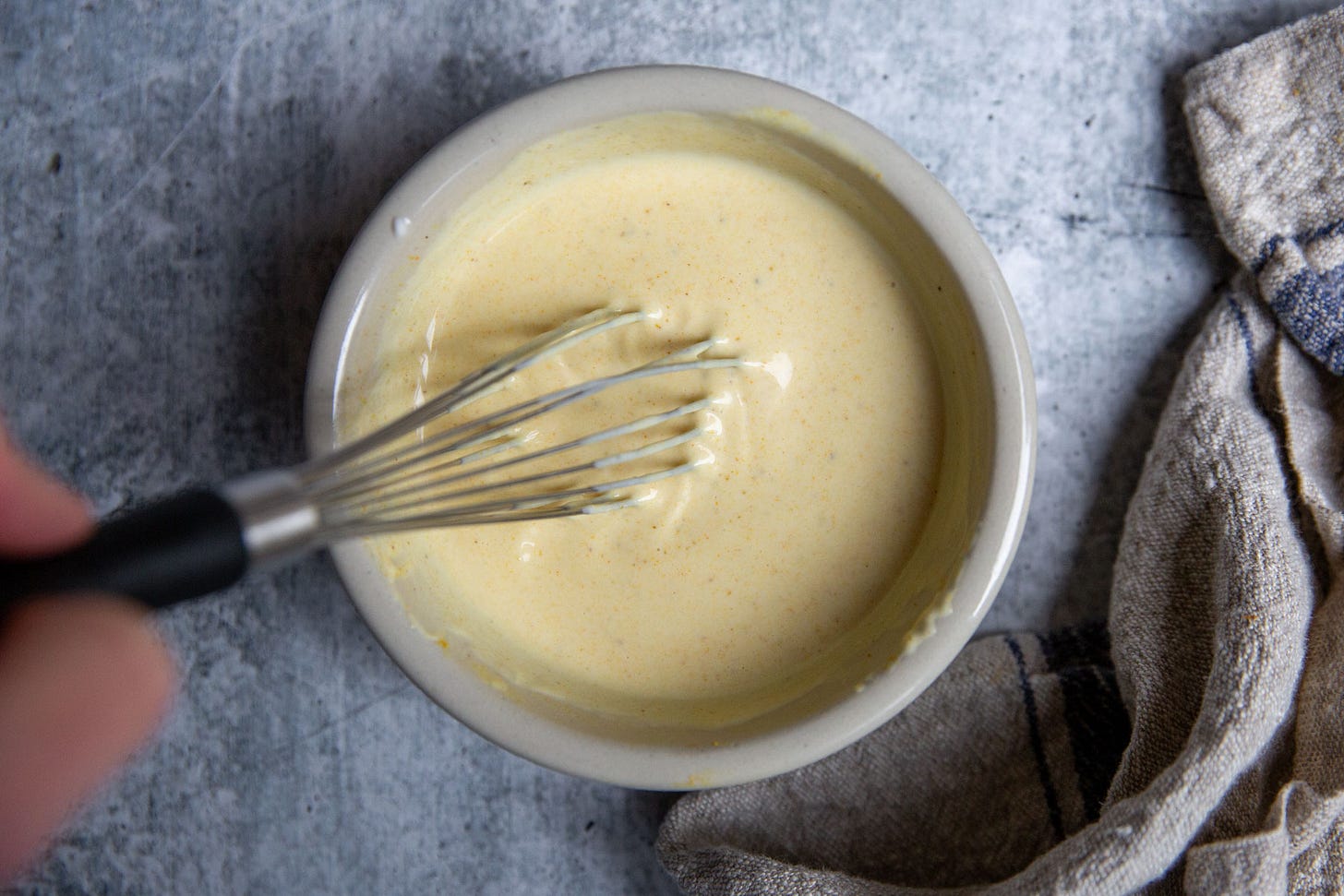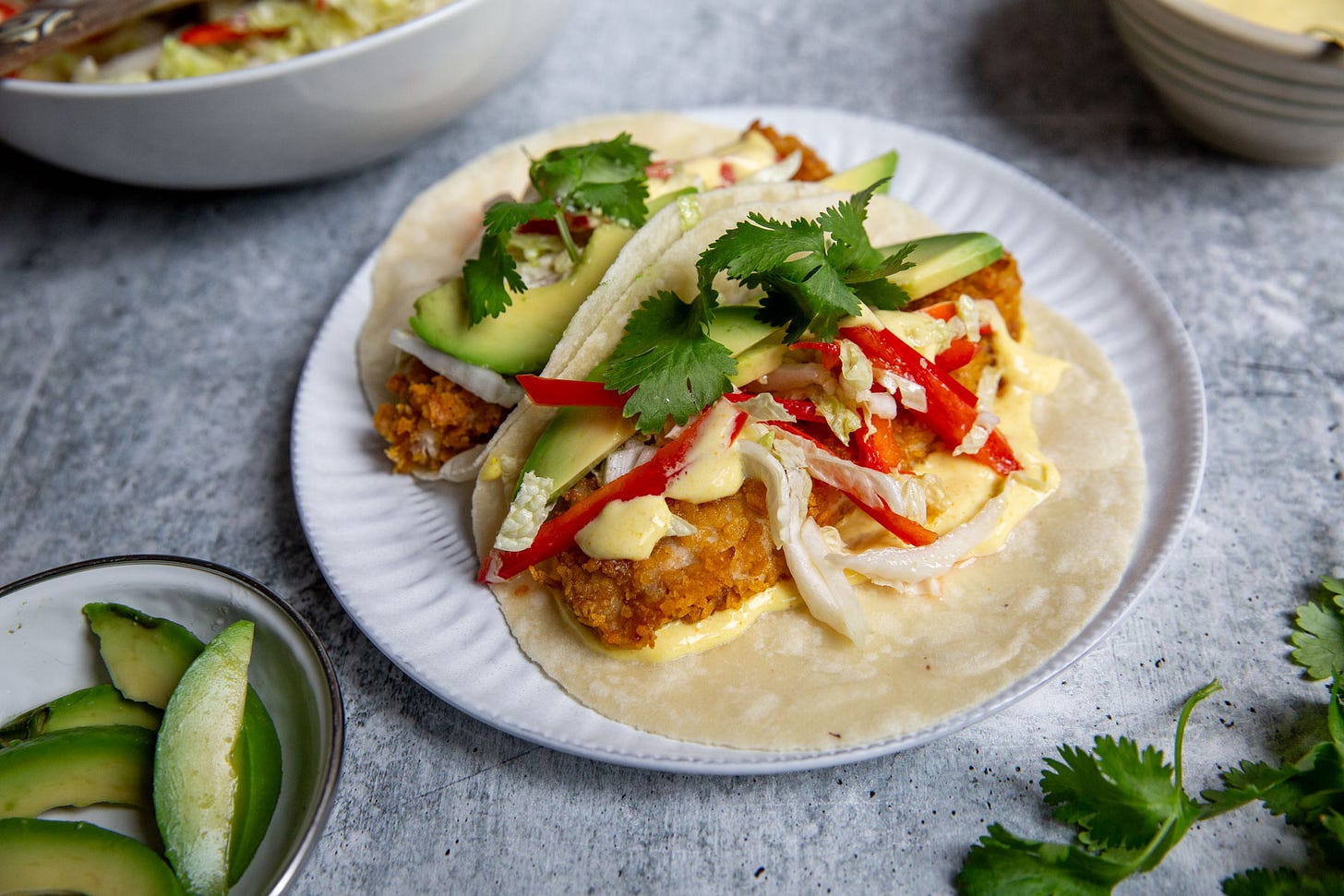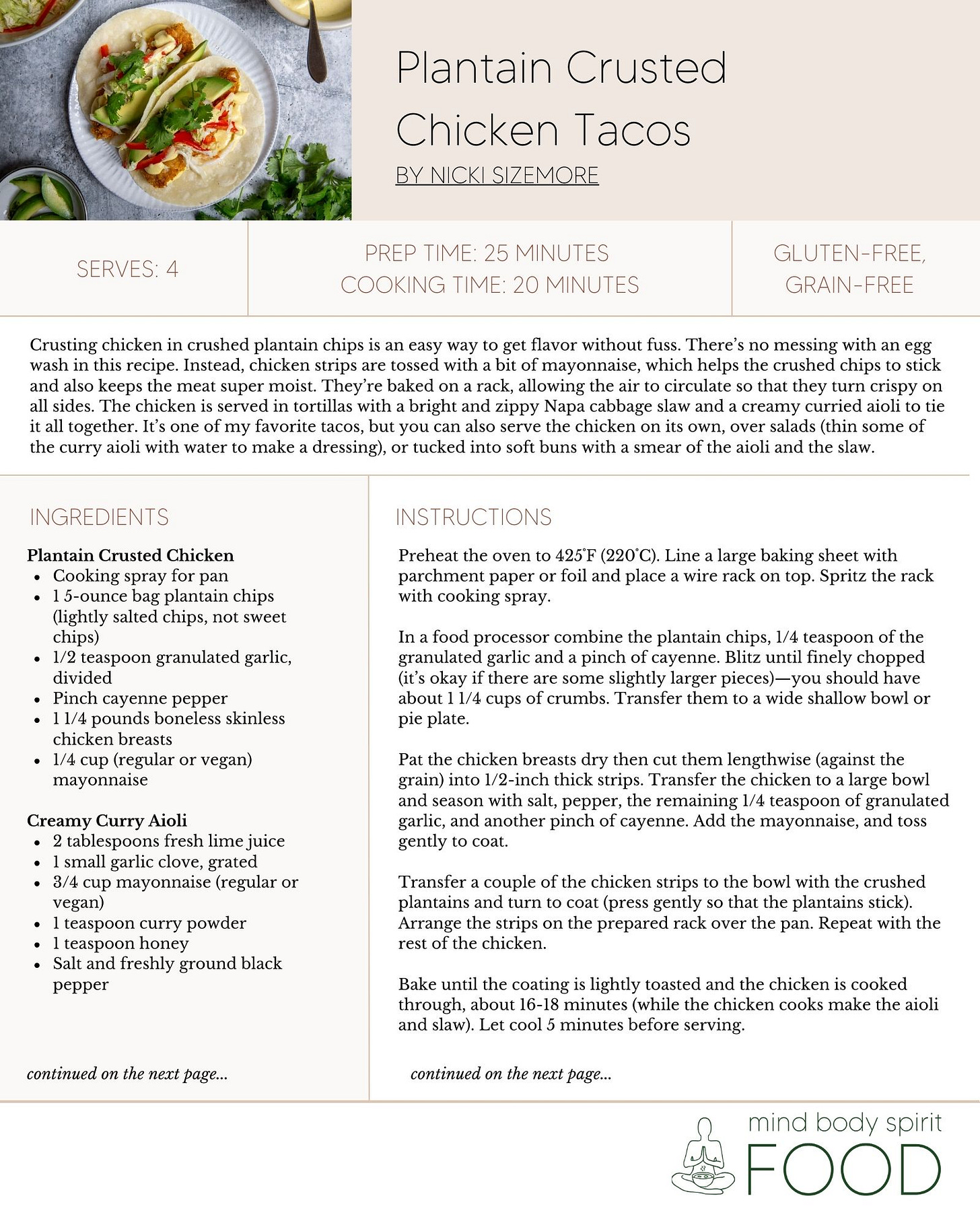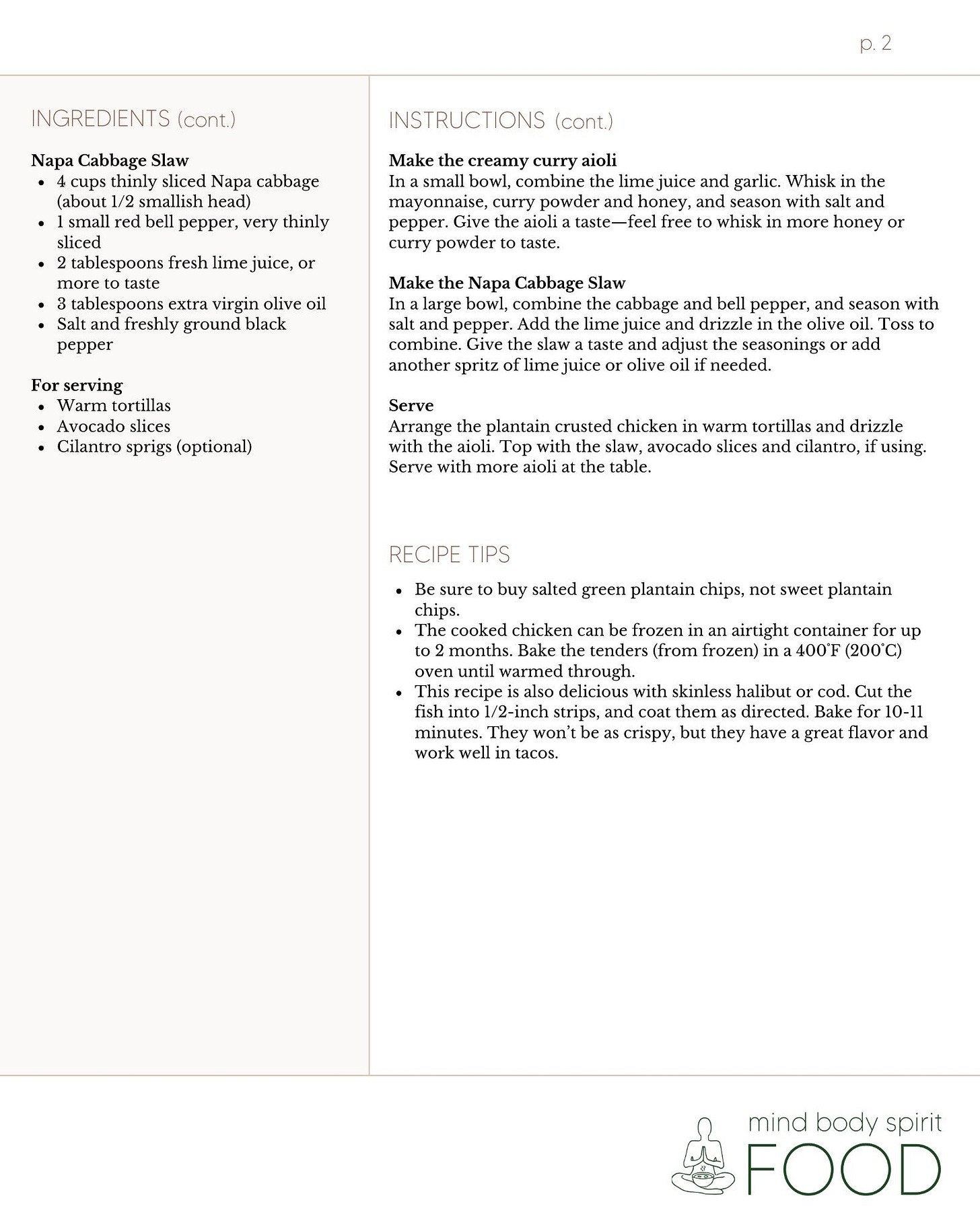Happy Friday, friends! Let me start by saying that I am not ready for all of the holiday content that’s flooding my Instagram feed. So today we’re making something totally different (and maybe my favorite new taco?): plantain-crusted chicken tacos with a crunchy Napa cabbage slaw and a creamy curry aioli. The combination is incredible, but the baked plantain chicken is worth making in its own right. Before we dive in, however, let’s talk about cooking for others. Actually, what I really want to talk about is how we value ourselves (is there a link?).
Cooking for families
If you’ve ever cooked for kids, you’ve probably had the experience of feeling dejected when a meal that you’ve spent time and effort preparing gets spat out or pushed away (sometimes without even taking a single bite!). When my girls were little I’d feel personally offended if they didn’t like what I cooked (and, on the flip side, I felt like a successful mother if they loved what I made). While there were many layers to this (including societal expectations—see below), as somebody who cooked for a living and identified strongly with that part of myself, it felt like if they didn’t like my food then I was failing in some way.
This led to an insidious battle of control—I would give them their beautifully portioned plates, then would feel angry or hurt when they refused to eat anything. (But I worked so hard! I’m expressing my love! The foods you eat are a reflection of how successful I am as a mom!)
When my now eight-year-old was a toddler the dinnertime battle became too much. We were locked in stalemate, and nobody was enjoying themselves (or enjoying dinner). I was exhausted with it all, and I began just throwing the food out on the counter and letting everybody serve themselves (or, in my toddler’s case, giving her a little bit of everything on a suctioned-down plate that couldn’t be thrown across the room). This became the genesis of my book, Build-a-Bowl, in which the meals are designed as build-your-own situations.
In releasing control over what my kids put on their plates (and how Instagram-worthy their plates looked) I began to realize that I had been mistaking their tastes for my value as a mom and a chef. In reality, their preferences had absolutely nothing to do with me. Whether they liked or disliked something was their own sovereign business. It was a huge weight off my shoulders, emotionally as well as physically. I gave them their power back, and in doing so I found much more freedom for myself.
*That being said, we still demand that our kids are polite—it’s okay to not like something, but it’s not okay to be rude about it—and that they try at least a bite of everything, even if it’s a small nibble.
Cooking for friends
This lesson was a bit harder for me to learn when it came to cooking for friends. As a trained cook I used to put an immense amount of pressure on myself when having friends over, as I describe here. I was afraid of what people would think if the chicken wasn’t perfectly juicy or if the dessert wasn’t drop-dead delicious (I’d be a sham!).
Most of us put pressure on ourselves when cooking for others, no matter our culinary backgrounds. We want people to like our food, and we also want to be applauded for our efforts. We get wrapped up in making the perfect roast chicken or most gorgeous cake, instead of having any fun in the process. It wasn’t until the pandemic hit and we were forced to stop having friends over that I realized that I was tied up in a web of perfectionism. I was putting the perceptions of others before my own well being, swimming in a fear of judgement.
What is success?
It’s important to note that these experiences were heavily bound up in patriarchal programming. As wives and mothers, society leads us to believe that our worth is reflected in the amount of broccoli our kids consume, or in how beautiful our homes are, or in how effortlessly we serve others. But even more generally as humans, we’re conditioned to believe that our worth comes from outside ourselves—it’s something that’s granted to us. We therefore seek the accolades, objects and experiences that prove that we are worthy. We place our notions of “success” in how well we perform (discarding how we might feel along the way). The judgements of others become more important than our own inner knowing.
That kind of success is a false cage that only serves to bind us up tight. My friend Nicole Beaudin, who’s a business coach, once asked me to write down what success meant to me, and the first thing I wrote, before my mind could jump in, was: “Having time to sit and be present with myself and with my family.” I was shocked at those words, and I revisit them often. In my core of cores, success isn’t about prizes and recognition, it’s about a life where I have the ability to sit quietly, in connection with myself and with the people around me.
Worthiness (is not something we earn)
Our worth is inherent. It just is. It’s not found in whether or not people like or dislike our cooking, or in how perfectly we raise our kids, or in how messy our houses are, or in any outside parameters. While feeding people can be a beautiful expression of love and caring, this is only if we drop attachments to how those we feed will perceive our efforts. It doesn’t matter if they like or dislike the food we make. It’s not about putting a perfect plate of food in front of somebody. It’s about standing in our worth and sharing the food we make because it feels good to do so.
This is not easy work, standing in our worth. We’re hardwired to seek the approval of others out of a fear of being ostracized. Just a couple of weeks ago I hit up against my own self-doubt, as I described here. It’s a lot easier to stay within the web of conditioning rather than risk being judged. It feels safer to stay small and stick with the norm than to take the risk of following our own unique soul’s path. But how else will we evolve? How else can we change the systems that are no longer working in our lives unless we have the courage to step out of them, in pursuit of whatever it is that feels authentic and true for us?
When we stand in our worth, we gain power. The more we feel our own inherent value, the more we can see it in others. This isn’t about surface-level narcicissm, but rather a deep, heart-felt understanding that each and every one of us has a reason for being here. We all have a soul’s purpose, no matter how simple or strange that path might appear (here I am writing a newsletter about food but also about what it means to be a human and maybe even about spirituality—it’s weird!). Only when we embody and celebrate our own unique purpose, can we honor and celebrate this in others.
So yes, this is kind of an essay about feeding others, but it’s really asking you how you feel about yourself. What if we all agreed that there was never any need to impress? What if we allowed things to get messy and splattered, knowing that oftentimes burning shit is the best way to learn? As
reminded me in her newsletter this week:You are loved and worthy even when you think you have failed.
Invitation this week
If you’re going to be cooking for others this week, my invitation is to find your own footing first. Ground yourself in your worth, releasing the desire for approval. Allow the people at your table to have their own experiences with the foods they eat, knowing that their preferences have absolutely nothing to do with you. And most of all, celebrate YOU—the wonderfully divine and utterly unique person you are. You’re so damn worth it.
Related essays & podcasts:
Plantain Crusted Chicken Tacos
This is really two recipes in one, as the baked plantain crusted chicken tenders are delicious all on their own. Instead of messing with an egg wash, chicken strips are simply tossed in a bit of mayonnaise before coating, helping crushed plantain chips to stick (as well as ensuring super moist meat).
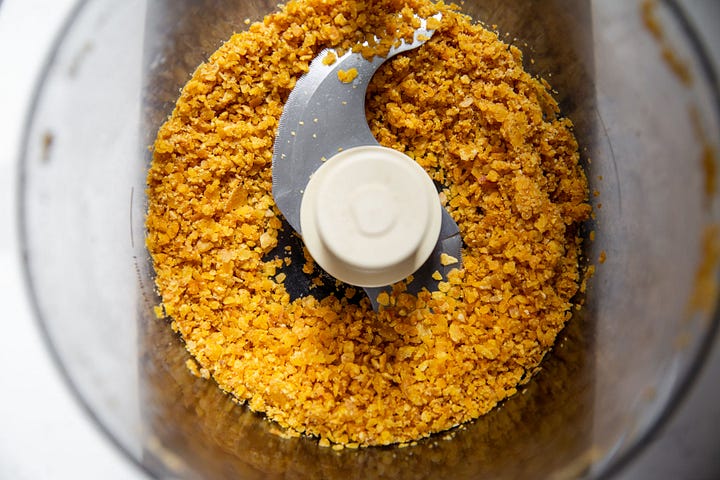
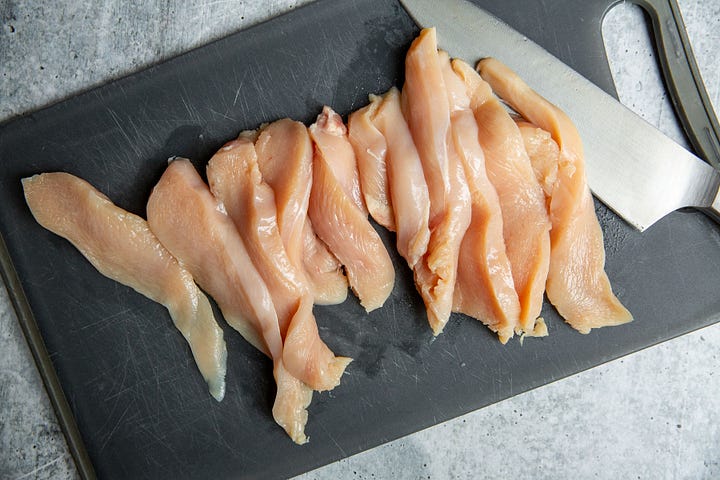
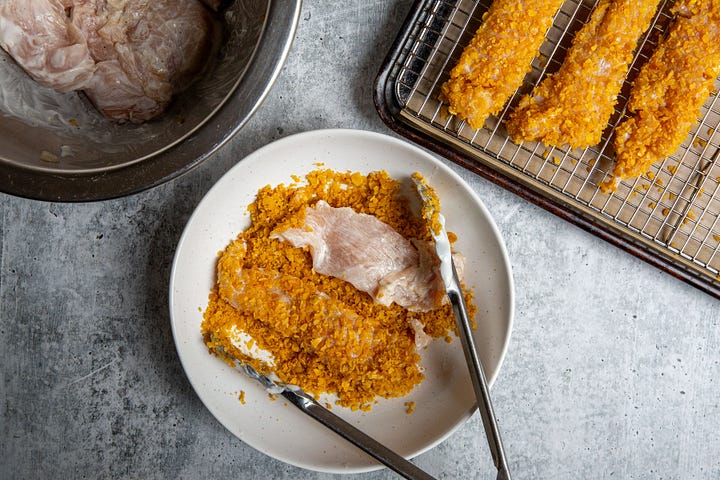

I serve them with a cool curry aioli, which is subtly sweet and pairs magnificently with the plantain crust. However, when I first tested the recipe, my kids just wanted ketchup. Years ago this undoubtedly would have annoyed me. Somehow their *constant* desire for ketchup always felt like a diminishment of my ability as a chef (you seriously want to put ketchup on that perfectly seared pork chop in an apple cider reduction??). Oh, silly me: they like ketchup because it’s sweet and tangy! So, I invite you to let your people decide for themselves.
Now, for the tacos. At some point I decided to put the chicken tenders in tortillas with the aioli and a bright Napa cabbage slaw, and it was revelatory. This is the taco of my dreams—it’s loaded with texture and flavor, and that creamy aioli ties it all together.
Recipe tips:
Be sure to buy salted green plantain chips, not sweet plantain chips.
The cooked chicken tenders can be frozen in an airtight container for up to 2 months. Bake them (from frozen) in a 400˚F (200˚C) oven until warmed through.
You could also dice up the chicken and serve it over a salad with the thinned aioli as a dressing!
This recipe is also delicious with skinless halibut or cod. Cut the fish into 1/2-inch strips, and coat them as directed. Bake for 10-11 minutes. They won’t be as crispy, but they have a great flavor and work well in tacos.
You can download a PDF of the full recipe here (I’ve also included text and JPEG versions of the recipe below):
Watch how the recipe comes together in this video:
Wishing you a wonderful weekend. Remember to nourish yourself with intention and love.
xo, Nicki
Instagram | TikTok | Recipe Index | More Recipes | Cookbooks | Classes
More taco recipes:
Plantain Crusted Chicken Tacos with Curry Aioli
Serves: 4-6 | Prep time: 25 minutes | Cooking time: 20 minutes
Cooking spray for pan
1 5-ounce bag plantain chips (lightly salted chips, not sweet chips)
1/2 teaspoon granulated garlic, divided
Pinch cayenne pepper
1 1/4 pounds boneless skinless chicken breasts
1/4 cup (regular or vegan) mayonnaise
Creamy Curry Aioli
2 tablespoons fresh lime juice
1 small garlic clove, grated
3/4 cup mayonnaise (regular or vegan)
1 teaspoon curry powder
1 teaspoon honey
Salt and freshly ground black pepper
Napa Cabbage Slaw
4 cups thinly sliced Napa cabbage (about 1/2 smallish head)
1 small red bell pepper, very thinly sliced
2 tablespoons fresh lime juice, or more to taste
3 tablespoons extra virgin olive oil
Salt and freshly ground black pepper
For serving
Warm tortillas
Avocado slices
Cilantro sprigs (optional)
Preheat the oven to 425˚F (220˚C). Line a large baking sheet with parchment paper or foil and place a wire rack on top. Spritz the rack with cooking spray.
In a food processor combine the plantain chips, 1/4 teaspoon of the granulated garlic and a pinch of cayenne. Blitz until finely chopped (it’s okay if there are some slightly larger pieces)—you should have about 1 1/4 cups of crumbs. Transfer them to a wide shallow bowl or pie plate.
Pat the chicken breasts dry then cut them lengthwise (against the grain) into 1/2-inch thick strips. Transfer the chicken to a large bowl and season with salt, pepper, the remaining 1/4 teaspoon of granulated garlic, and another pinch of cayenne. Add the mayonnaise, and toss gently to coat.
Transfer a couple of the chicken strips to the bowl with the crushed plantains and turn to coat (press gently so that the plantains stick). Arrange the strips on the prepared rack over the pan. Repeat with the rest of the chicken.
Bake until the coating is lightly toasted and the chicken is cooked through, about 16-18 minutes (while the chicken cooks make the aioli and slaw). Let cool 5 minutes before serving.
Make the creamy curry aioli
In a small bowl, combine the lime juice and garlic. Whisk in the mayonnaise, curry powder and honey, and season with salt and pepper. Give the aioli a taste—feel free to whisk in more honey or curry powder to taste.
Make the Napa Cabbage Slaw
In a large bowl, combine the cabbage and bell pepper, and season with salt and pepper. Add the lime juice and drizzle in the olive oil. Toss to combine. Give the slaw a taste and adjust the seasonings or add another spritz of lime juice or olive oil if needed.
Serve
Arrange the plantain crusted chicken in warm tortillas and drizzle with the aioli. Top with the slaw, avocado slices and cilantro, if using. Serve with more aioli at the table.
Do Ahead: The cooked chicken can be frozen in an airtight container for up to 2 months. Bake it (from frozen) in a 400˚F (200˚C) oven until warmed through.


